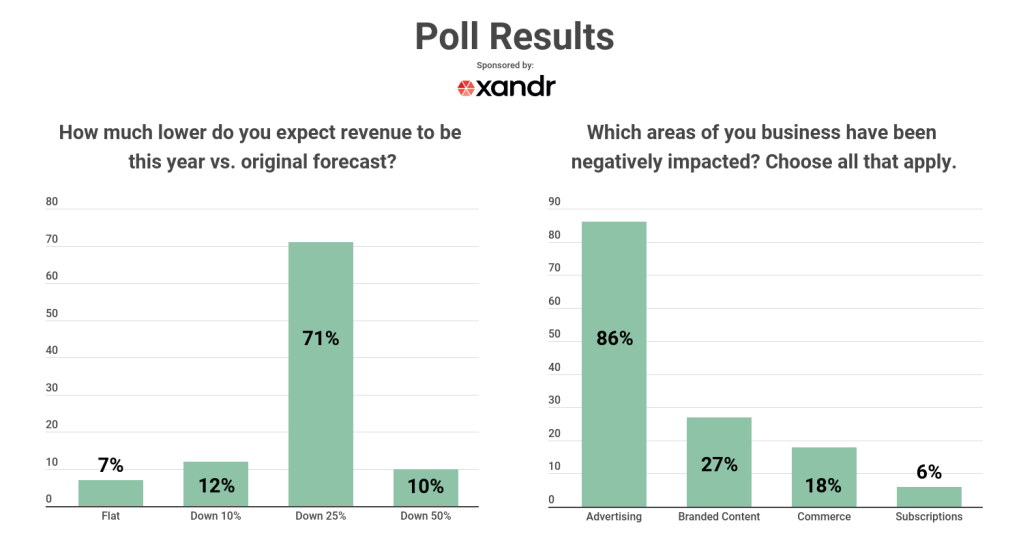Save 50% on a 3-month Digiday+ membership. Ends Dec 5.
Advertisers ‘don’t want to sound tone deaf’: Candid thoughts of publishers navigating crisis

Publishers are grappling with how to say solvent while facing declining advertising revenue, lost event sponsorships and ticket sales and dwindling commerce revenue.
While the Digiday Publishing Summit couldn’t take place in person in Vail, Colorado this year, would-be attendees still gathered virtually to discuss the challenges they’re facing within their businesses and what their strategies are for weathering the storm. Like most of our in-person town halls, this conversation was conducted under the Chatham House Rule, which allows reporters to share what people say without identifying them by name or company.
Panic pauses from clients decreases everyone’s advertising revenue.
Many advertisers are pausing ad campaigns due to financial strain and that is hard to debate. But for clients that are hesitating on their spend due to concerns around messaging against the coronavirus content, publishers can take a consultative approach to teach them how to make the messaging service related, in order to be a brand that is remembered as being front and center in having helped people during the pandemic.
“Not letting an advertiser out of whatever they want to do is a very short-term decision for your business. If you run this client’s campaign and it’s tone deaf and you force them to deliver you $100,000 or $500,000, when those lights come back on, they’re not coming back to you and that damage can be irreparable.”
Publishers are planning for a 25% to 30% hit to their advertising business.
One publisher said that advertisements running on coronavirus-related content are seeing a slight decrease in click-through rates. Though they attributed this dip to the type of inventory and campaigns running on those pages (more an increase of ads sold on the open auction versus higher impact ads) than to actual performance of the ads themselves.
Ad position: web_incontent_pos1
Separately, an executive at a large digital publisher said it is seeing 30% lower CPMs on coronavirus pages versus non-coronavirus pages.
“Either supply chains are broken or they’re afraid of coronavirus adjacency — not because of brand safety but because they don’t want to sound tone deaf.”
Non-news publishers are seeing a drop-off in traffic.
For some publishers with non-news related content that audiences consume habitually, traffic may be down due to the break in the daily routine. One such publisher experiencing this found that traffic was down 25% last month. In these cases, subscriptions and direct sold campaigns were the most stable part of their business while programmatic is down upwards of 20% and other consumer products have not sold as much due to the decrease in traffic.
Ad position: web_incontent_pos2
“If you’re not adapting your content strategy, you’re probably missing something. But from a product standpoint, I don’t think it’s time to change your products necessarily.”
The upside of virtual events is amplifying the audience.
When selling virtual events, obviously the networking and human interaction piece won’t be there, but the upside is amplifying the audience. While a live event might bring in a few hundred participants, a virtual event can be shared with more than 10 times that number. That value proposition is compelling and could potentially be a better product for partners.
Virtual events might not bring in as much revenue, but you can make up for that with saving time and money in planning it, such as turning out a new digital event in as little as 48 hours, according to one publisher.
“Our view is that we will see a dip in events revenue for this year just because it’s the nature of the beast. But through virtual events, there is a way to keep the business afloat.”
Events are multifaceted and not all events will be able to be replicated, especially large events like trade shows.
Making up all elements of the trade show is nearly impossible in a virtual format, especially for a two-or three-day conference because people won’t spend all that time in front of their computer. The other side of it is for trade shows that bring in tens of thousands of people and the loss of ticket revenue, which can be a few thousand dollars per pass, is significant. Therefore, rescheduling events to the fall is the best chance at recouping some of that money as a publisher, however that timeline is still hopeful at this point, several publishers agree.
“Sponsorships will be there but the pipeline for B2B media and those sellers are six to eight months. It’s not a consumer sell, so they’re going to need to get out a head of it here.”
More in Media

Digiday+ Research Subscription Index 2025: Subscription strategies from Bloomberg, The New York Times, Vox and others
Digiday’s third annual Subscription Index examines and measures publishers’ subscription strategies to identify common approaches and key tactics among Bloomberg, The New York Times, Vox and others.

From lawsuits to lobbying: How publishers are fighting AI
We may be closing out 2025, but publishers aren’t retreating from the battle of AI search — some are escalating it, and they expect the fight to stretch deep into 2026.

Media Briefing: Publishers turn to vertical video to compete with creators and grow ad revenue in 2026
Publishers add vertical video feeds to their sites to boost engagement, attract video ad spend and compete with news creators.
Ad position: web_bfu
